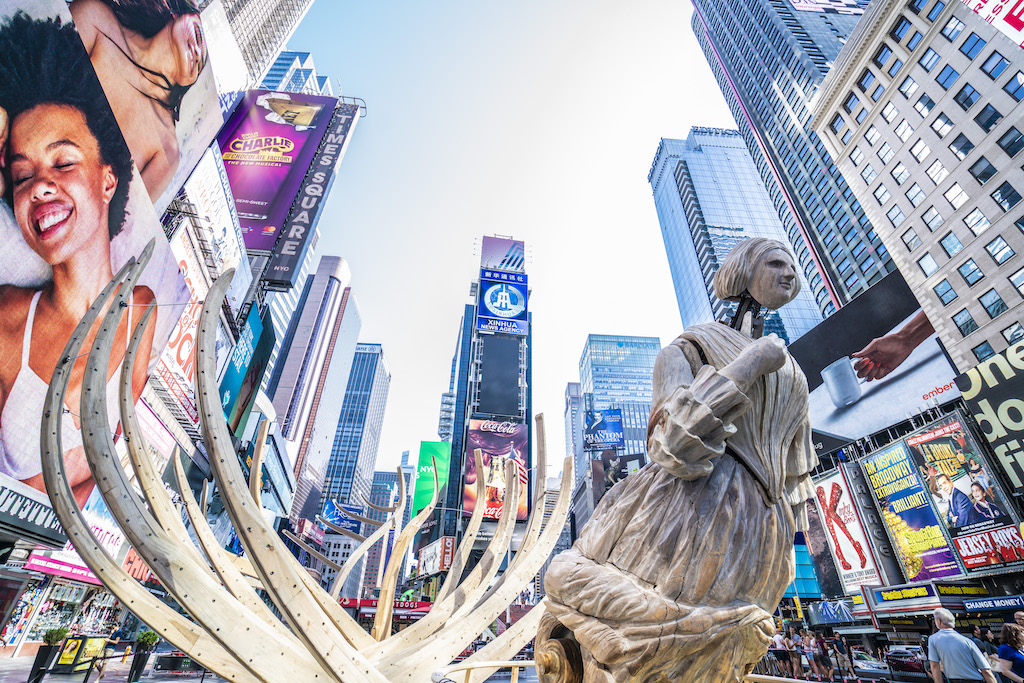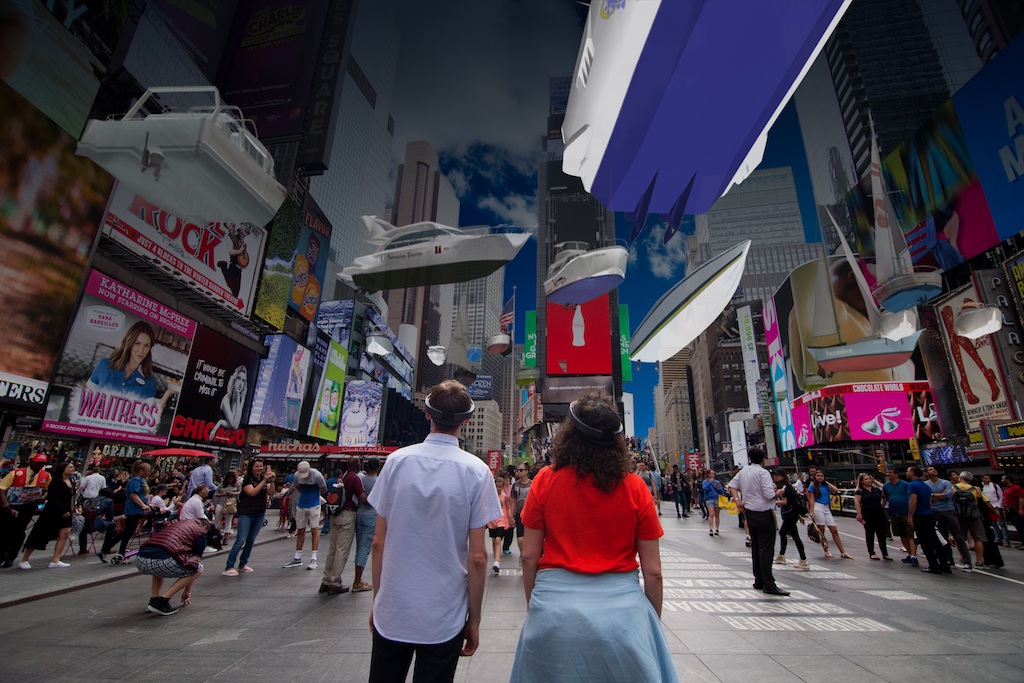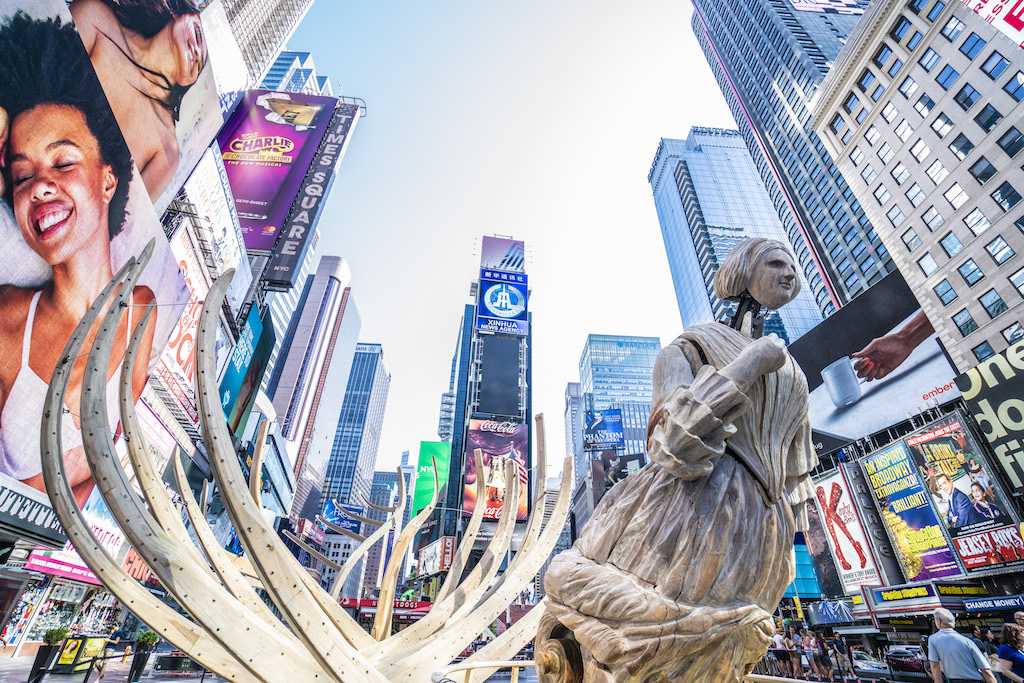[ad_1]

Mel Chin, Wake, 2018, multimedia.
COURTESY CHELSEA LIPMAN FOR TIMES SQUARE ARTS
Crowds gathered Wednesday under the blazing sun to witness the unveiling of two new works by Mel Chin in New York’s Times Square: Wake and Unmoored. The former is an imposing 60-foot-tall animatronic installation, while the latter is its digitally interactive “mixed reality” counterpart. Judging by the queue of eager viewers and the looks of curious passersby, the pieces—monumental and immersive, respectively—are well-suited for the spectacle of Midtown Manhattan.
Both works grapple with history, technological innovation, and climate change. Wake is a sculptural cross between a wrecked ship and the skeleton of a massive marine mammal, with a figure on the bow fashioned in the likeness of Jenny Lind, a 19th-century opera singer who performed in New York. Her robotic head gently nods, and her chest subtly expands and compresses. Her presence also references the violent history of a slave ship, the USS Nightingale, named for Lind, who was known in her time as the “Swedish Nightingale.” Alluding to New York’s evolution as a cultural hub and the history of slavery in the U.S., the work signals different specters of the past.

Mel Chin, Unmoored, 2018, mixed reality.
Unmoored, which can be experienced through a few Microsoft HoloLens headsets being handed out (through July 13) or a downloadable app with which a phone can be held up and activated visually, considers technological possibilities and perils by way of visions of a Times Square that has been submerged in water. In the virtual sequence, which lasts around four minutes, Lind’s body is propelled into the distance of the vast aquatic city, and then a rush of boats and sea lifeforms fill the scene. Though the images were hard to discern through the HoloLens in Wednesday’s bright light, the notion evokes rising sea levels that pose a serious threat to cities and humanity—and asks, as articulated by Chin himself at the opening, “How will you rise?”
On view in Times Square through September 5, the works are part of a multi-site exhibition, “Mel Chin: All Over the Place,” which is stationed most fully at the Queens Museum and also, underground at the Broadway-Lafayette Street subway stop, includes Signal, a multimedia installation, as well as Soundtrack, a sound piece that features reconfigured recordings from the 1, 5, 7, E, and F trains.
During a walkthrough before the opening, Laura Raicovich, co-curator of the exhibition and former director of the Queens Museum, told ARTnews that Chin’s practice connects art with some of “the most important issues of our time”—not just climate change but also expansive matters related to social and economic justice. Raicovich said it was “always a dream” to connect Times Square and the Queens Museum—in this case, they are linked by the 7 train, which she noted is “emblematic of the city and immigration.” Of the artist, Raicovich said, “His work is so profoundly relevant that New York should get a super dose of Mel Chin.”
Manon Slome, co-curator of the exhibition and co-founder and chief curator of the public art nonprofit No Longer Empty, called Unmoored “a nautical traffic jam,” while New York State Senator Brad Hoylman, who spoke at the unveiling, called the installation “a parting gift to Scott Pruitt,” the recently resigned Environmental Protection Agency head who has questioned and rejected scientific data related to climate change.
For the duration of the installation, on-site docents will offer visitors pamphlets with information regarding climate change. The sheets report, in part, “In 100 years, scientists predict that the sea level could rise six feet in New York City.” Slome said startling facts of the kind provide context. When viewers realize the artwork about climate change, she said, “then it starts to mean something.”
Speaking to the audience at the opening, Chin said of work meant to engage viewers with realities of the past and future, “It is about the spirit of friendship to provoke the essential questions of our time.”
[ad_2]
Source link

